Decision-Making Report: Analyzing Uber's Toxic Workplace Culture
VerifiedAdded on 2022/12/29
|13
|2563
|53
Report
AI Summary
This report examines the management decision-making processes at Uber, focusing on the issues of sexual harassment and a toxic organizational culture. It begins by identifying the core problems and the impact on the company. The report then applies the McKinsey 7S model to analyze the situation and proposes a strategic decision-making process to improve the workplace environment. The analysis includes recommendations for incorporating employees in the decision-making process and aligning change management objectives with organizational goals. The report concludes by suggesting measures Uber can take to permanently resolve these issues and foster sustainable business practices. It highlights the importance of a clear workplace policy to prevent future problems.
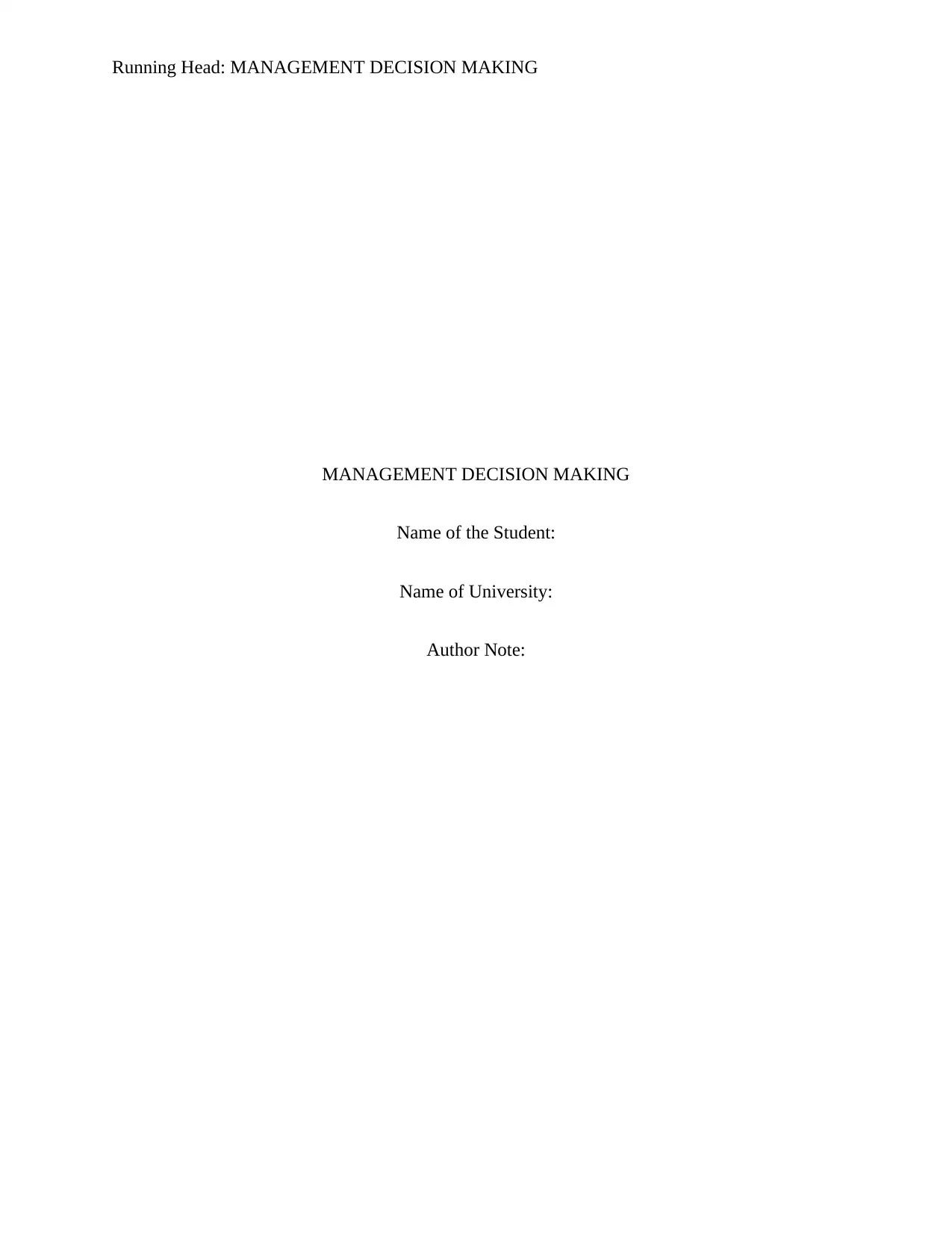
Running Head: MANAGEMENT DECISION MAKING
MANAGEMENT DECISION MAKING
Name of the Student:
Name of University:
Author Note:
MANAGEMENT DECISION MAKING
Name of the Student:
Name of University:
Author Note:
Paraphrase This Document
Need a fresh take? Get an instant paraphrase of this document with our AI Paraphraser
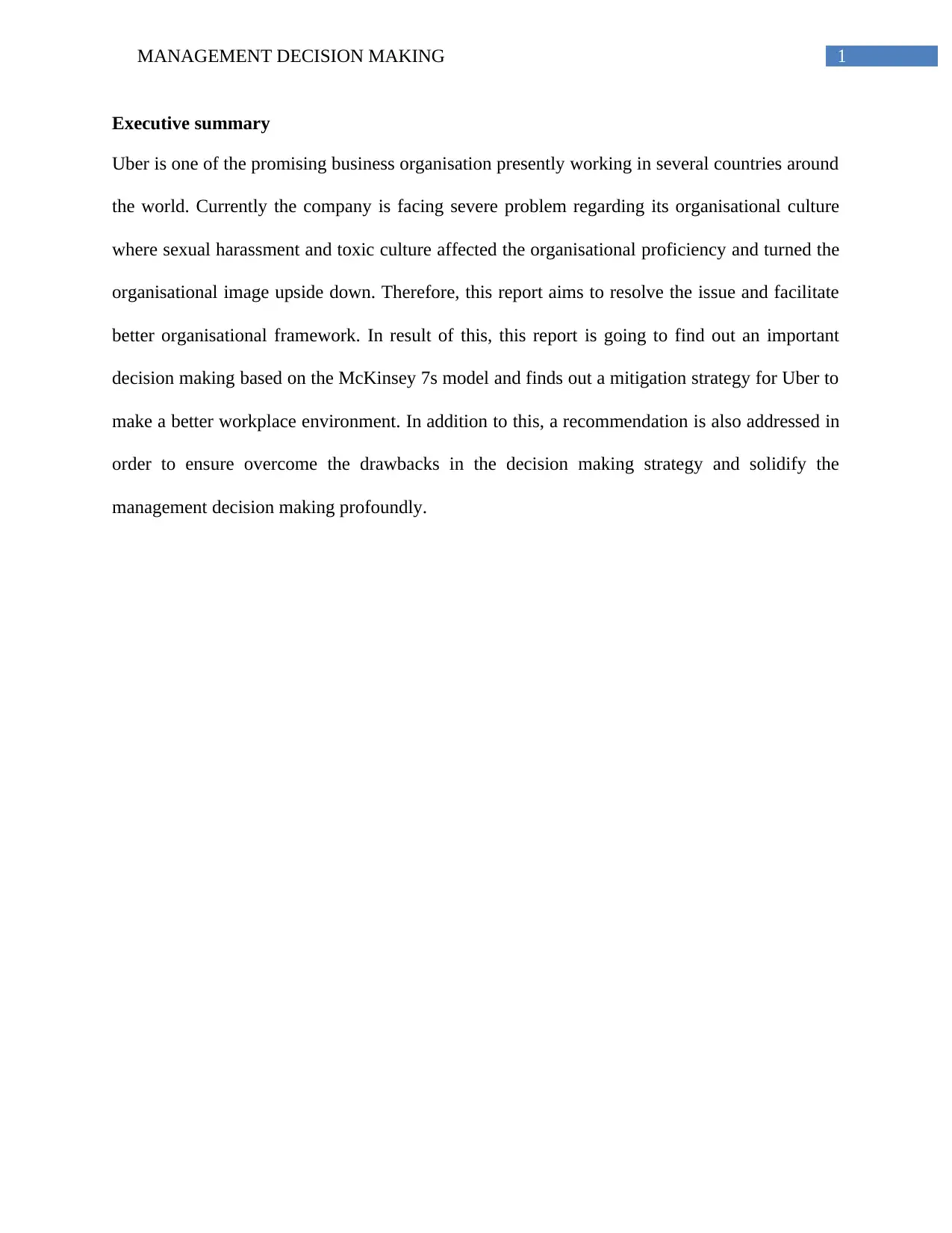
1MANAGEMENT DECISION MAKING
Executive summary
Uber is one of the promising business organisation presently working in several countries around
the world. Currently the company is facing severe problem regarding its organisational culture
where sexual harassment and toxic culture affected the organisational proficiency and turned the
organisational image upside down. Therefore, this report aims to resolve the issue and facilitate
better organisational framework. In result of this, this report is going to find out an important
decision making based on the McKinsey 7s model and finds out a mitigation strategy for Uber to
make a better workplace environment. In addition to this, a recommendation is also addressed in
order to ensure overcome the drawbacks in the decision making strategy and solidify the
management decision making profoundly.
Executive summary
Uber is one of the promising business organisation presently working in several countries around
the world. Currently the company is facing severe problem regarding its organisational culture
where sexual harassment and toxic culture affected the organisational proficiency and turned the
organisational image upside down. Therefore, this report aims to resolve the issue and facilitate
better organisational framework. In result of this, this report is going to find out an important
decision making based on the McKinsey 7s model and finds out a mitigation strategy for Uber to
make a better workplace environment. In addition to this, a recommendation is also addressed in
order to ensure overcome the drawbacks in the decision making strategy and solidify the
management decision making profoundly.
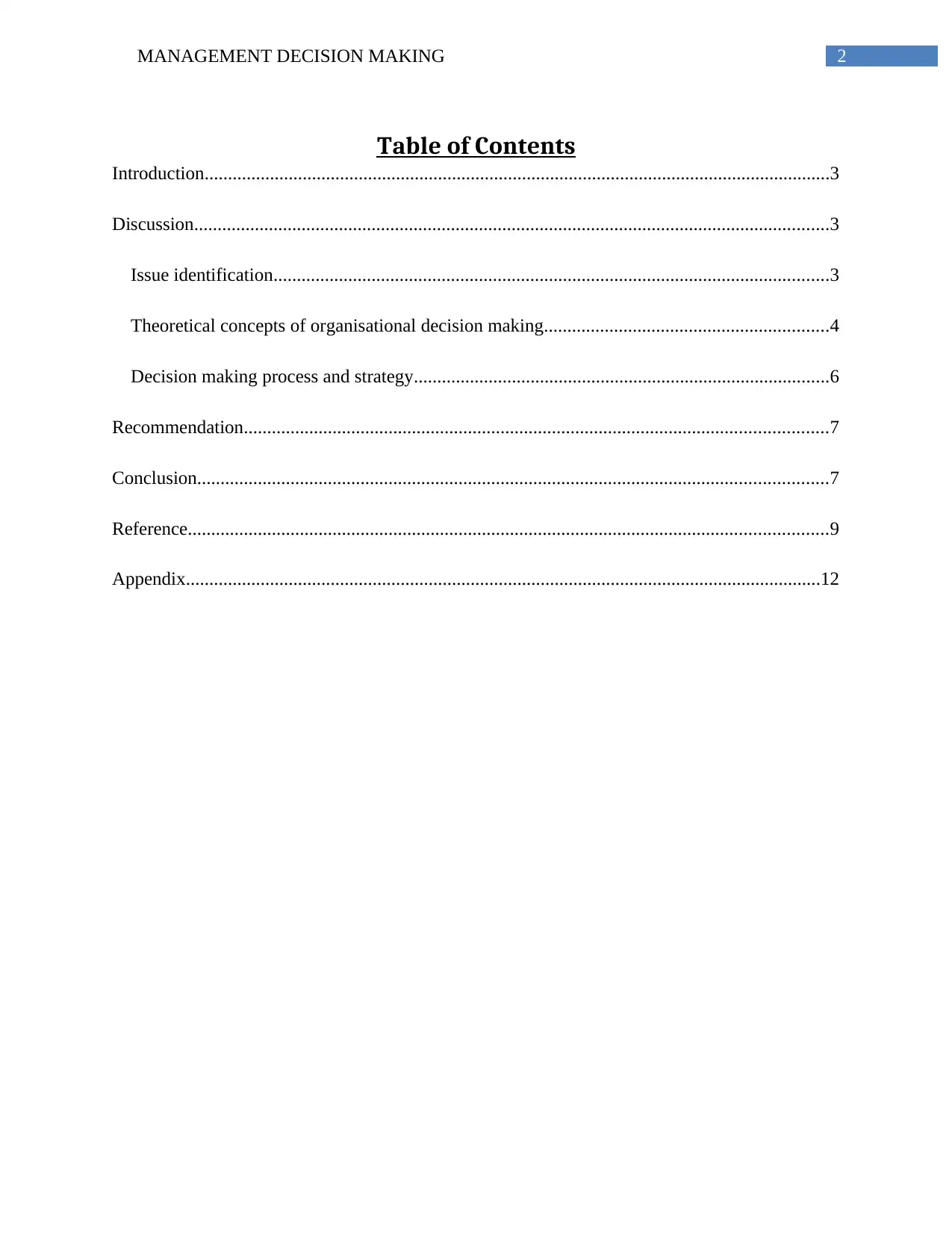
2MANAGEMENT DECISION MAKING
Table of Contents
Introduction......................................................................................................................................3
Discussion........................................................................................................................................3
Issue identification.......................................................................................................................3
Theoretical concepts of organisational decision making.............................................................4
Decision making process and strategy.........................................................................................6
Recommendation.............................................................................................................................7
Conclusion.......................................................................................................................................7
Reference.........................................................................................................................................9
Appendix........................................................................................................................................12
Table of Contents
Introduction......................................................................................................................................3
Discussion........................................................................................................................................3
Issue identification.......................................................................................................................3
Theoretical concepts of organisational decision making.............................................................4
Decision making process and strategy.........................................................................................6
Recommendation.............................................................................................................................7
Conclusion.......................................................................................................................................7
Reference.........................................................................................................................................9
Appendix........................................................................................................................................12
⊘ This is a preview!⊘
Do you want full access?
Subscribe today to unlock all pages.

Trusted by 1+ million students worldwide
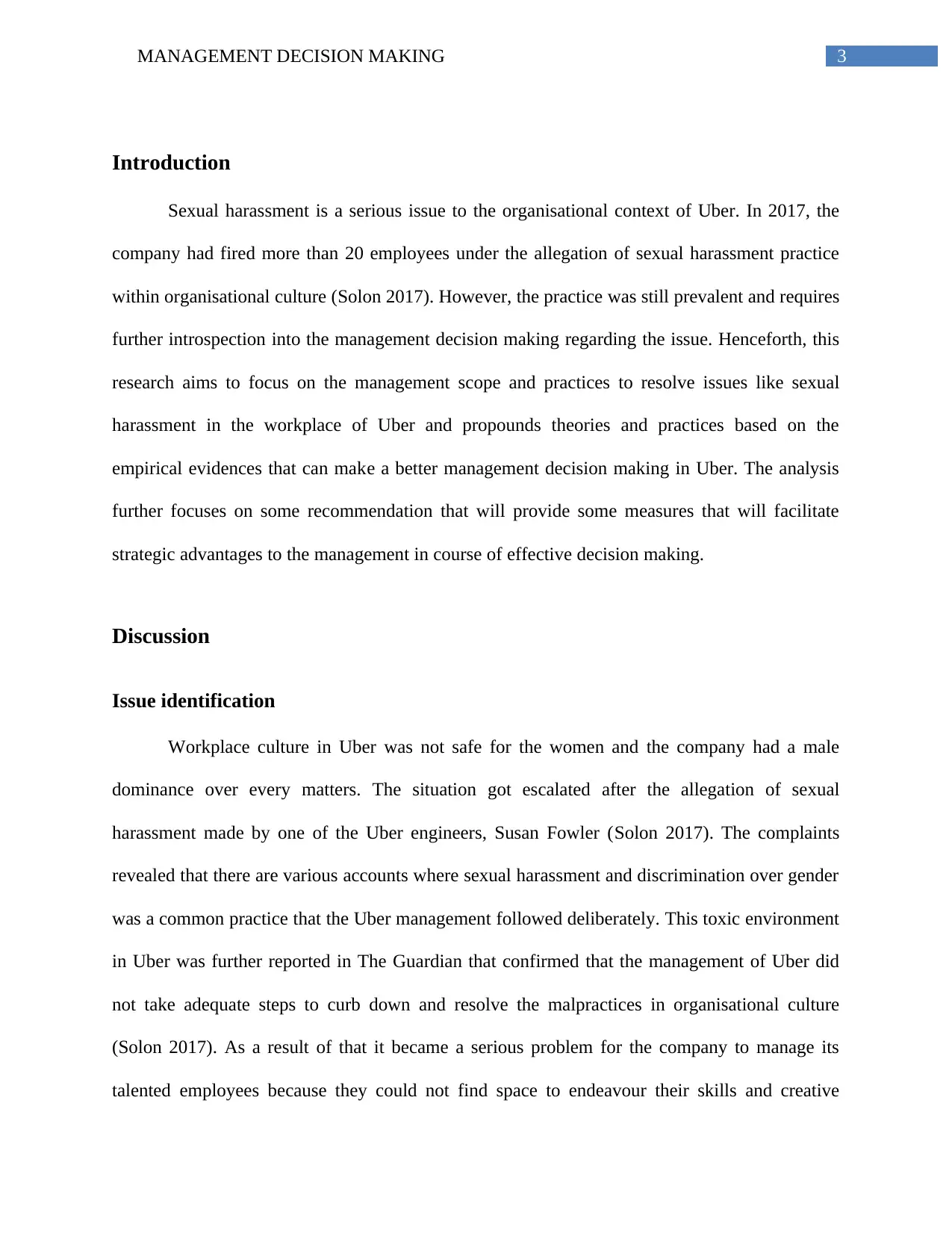
3MANAGEMENT DECISION MAKING
Introduction
Sexual harassment is a serious issue to the organisational context of Uber. In 2017, the
company had fired more than 20 employees under the allegation of sexual harassment practice
within organisational culture (Solon 2017). However, the practice was still prevalent and requires
further introspection into the management decision making regarding the issue. Henceforth, this
research aims to focus on the management scope and practices to resolve issues like sexual
harassment in the workplace of Uber and propounds theories and practices based on the
empirical evidences that can make a better management decision making in Uber. The analysis
further focuses on some recommendation that will provide some measures that will facilitate
strategic advantages to the management in course of effective decision making.
Discussion
Issue identification
Workplace culture in Uber was not safe for the women and the company had a male
dominance over every matters. The situation got escalated after the allegation of sexual
harassment made by one of the Uber engineers, Susan Fowler (Solon 2017). The complaints
revealed that there are various accounts where sexual harassment and discrimination over gender
was a common practice that the Uber management followed deliberately. This toxic environment
in Uber was further reported in The Guardian that confirmed that the management of Uber did
not take adequate steps to curb down and resolve the malpractices in organisational culture
(Solon 2017). As a result of that it became a serious problem for the company to manage its
talented employees because they could not find space to endeavour their skills and creative
Introduction
Sexual harassment is a serious issue to the organisational context of Uber. In 2017, the
company had fired more than 20 employees under the allegation of sexual harassment practice
within organisational culture (Solon 2017). However, the practice was still prevalent and requires
further introspection into the management decision making regarding the issue. Henceforth, this
research aims to focus on the management scope and practices to resolve issues like sexual
harassment in the workplace of Uber and propounds theories and practices based on the
empirical evidences that can make a better management decision making in Uber. The analysis
further focuses on some recommendation that will provide some measures that will facilitate
strategic advantages to the management in course of effective decision making.
Discussion
Issue identification
Workplace culture in Uber was not safe for the women and the company had a male
dominance over every matters. The situation got escalated after the allegation of sexual
harassment made by one of the Uber engineers, Susan Fowler (Solon 2017). The complaints
revealed that there are various accounts where sexual harassment and discrimination over gender
was a common practice that the Uber management followed deliberately. This toxic environment
in Uber was further reported in The Guardian that confirmed that the management of Uber did
not take adequate steps to curb down and resolve the malpractices in organisational culture
(Solon 2017). As a result of that it became a serious problem for the company to manage its
talented employees because they could not find space to endeavour their skills and creative
Paraphrase This Document
Need a fresh take? Get an instant paraphrase of this document with our AI Paraphraser
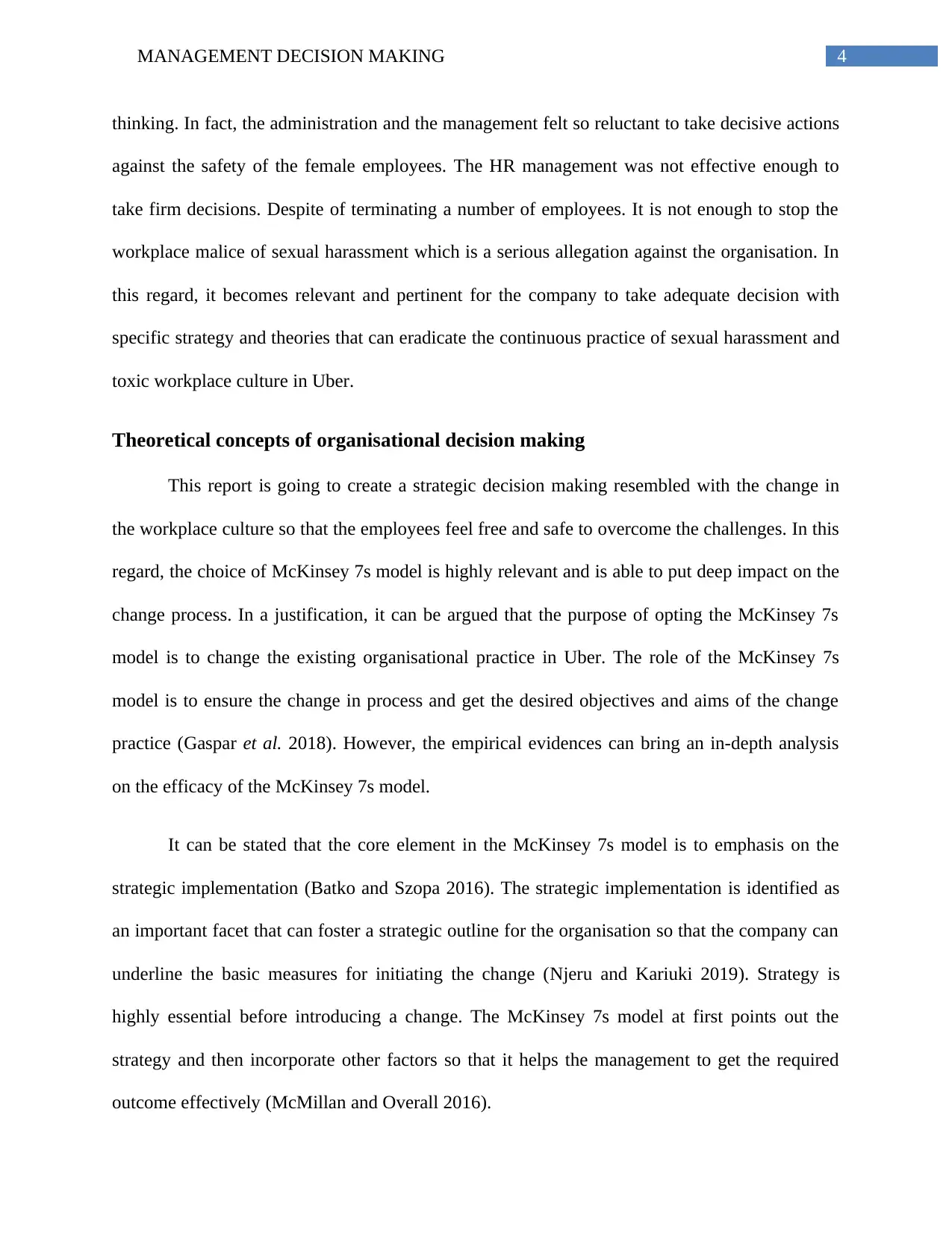
4MANAGEMENT DECISION MAKING
thinking. In fact, the administration and the management felt so reluctant to take decisive actions
against the safety of the female employees. The HR management was not effective enough to
take firm decisions. Despite of terminating a number of employees. It is not enough to stop the
workplace malice of sexual harassment which is a serious allegation against the organisation. In
this regard, it becomes relevant and pertinent for the company to take adequate decision with
specific strategy and theories that can eradicate the continuous practice of sexual harassment and
toxic workplace culture in Uber.
Theoretical concepts of organisational decision making
This report is going to create a strategic decision making resembled with the change in
the workplace culture so that the employees feel free and safe to overcome the challenges. In this
regard, the choice of McKinsey 7s model is highly relevant and is able to put deep impact on the
change process. In a justification, it can be argued that the purpose of opting the McKinsey 7s
model is to change the existing organisational practice in Uber. The role of the McKinsey 7s
model is to ensure the change in process and get the desired objectives and aims of the change
practice (Gaspar et al. 2018). However, the empirical evidences can bring an in-depth analysis
on the efficacy of the McKinsey 7s model.
It can be stated that the core element in the McKinsey 7s model is to emphasis on the
strategic implementation (Batko and Szopa 2016). The strategic implementation is identified as
an important facet that can foster a strategic outline for the organisation so that the company can
underline the basic measures for initiating the change (Njeru and Kariuki 2019). Strategy is
highly essential before introducing a change. The McKinsey 7s model at first points out the
strategy and then incorporate other factors so that it helps the management to get the required
outcome effectively (McMillan and Overall 2016).
thinking. In fact, the administration and the management felt so reluctant to take decisive actions
against the safety of the female employees. The HR management was not effective enough to
take firm decisions. Despite of terminating a number of employees. It is not enough to stop the
workplace malice of sexual harassment which is a serious allegation against the organisation. In
this regard, it becomes relevant and pertinent for the company to take adequate decision with
specific strategy and theories that can eradicate the continuous practice of sexual harassment and
toxic workplace culture in Uber.
Theoretical concepts of organisational decision making
This report is going to create a strategic decision making resembled with the change in
the workplace culture so that the employees feel free and safe to overcome the challenges. In this
regard, the choice of McKinsey 7s model is highly relevant and is able to put deep impact on the
change process. In a justification, it can be argued that the purpose of opting the McKinsey 7s
model is to change the existing organisational practice in Uber. The role of the McKinsey 7s
model is to ensure the change in process and get the desired objectives and aims of the change
practice (Gaspar et al. 2018). However, the empirical evidences can bring an in-depth analysis
on the efficacy of the McKinsey 7s model.
It can be stated that the core element in the McKinsey 7s model is to emphasis on the
strategic implementation (Batko and Szopa 2016). The strategic implementation is identified as
an important facet that can foster a strategic outline for the organisation so that the company can
underline the basic measures for initiating the change (Njeru and Kariuki 2019). Strategy is
highly essential before introducing a change. The McKinsey 7s model at first points out the
strategy and then incorporate other factors so that it helps the management to get the required
outcome effectively (McMillan and Overall 2016).
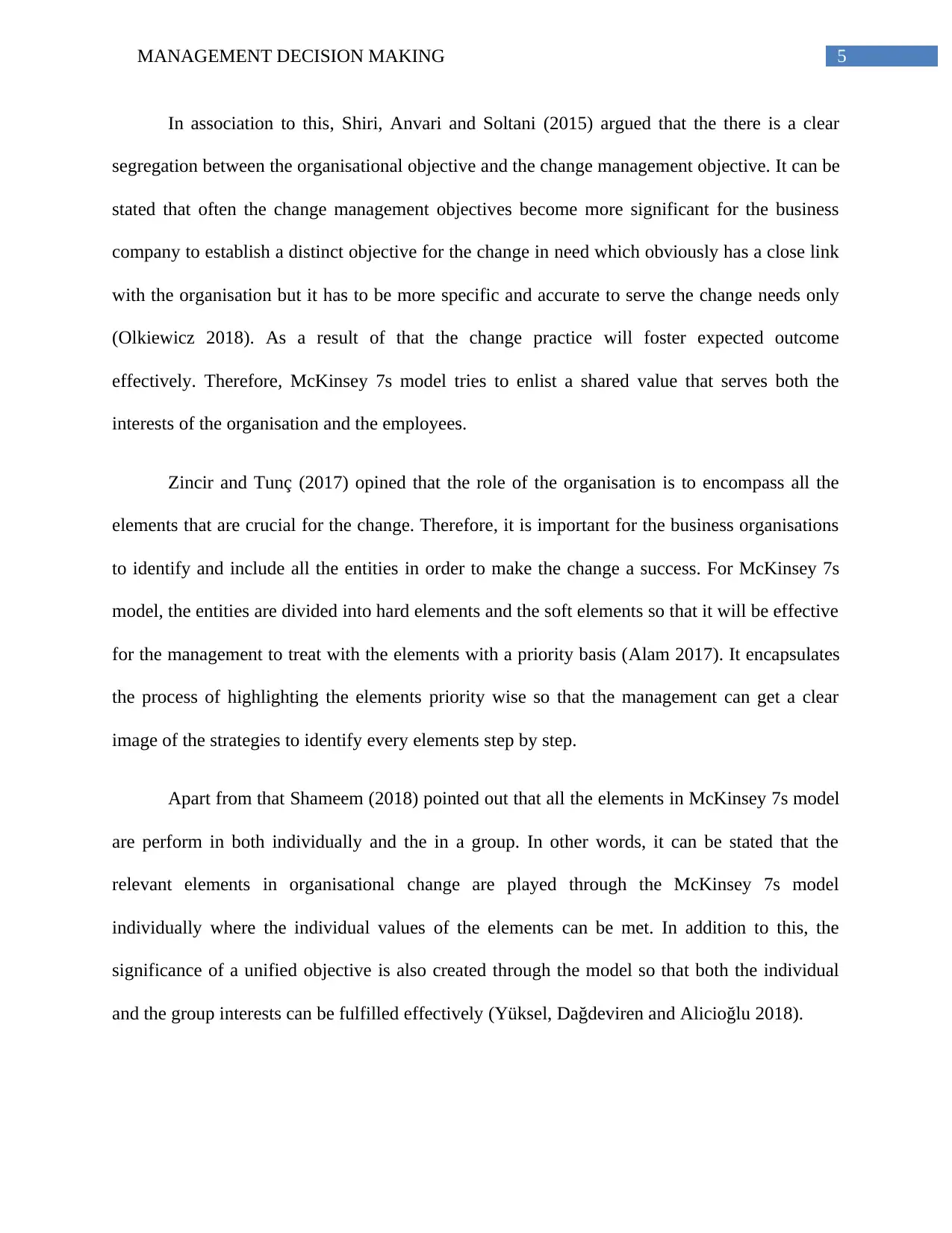
5MANAGEMENT DECISION MAKING
In association to this, Shiri, Anvari and Soltani (2015) argued that the there is a clear
segregation between the organisational objective and the change management objective. It can be
stated that often the change management objectives become more significant for the business
company to establish a distinct objective for the change in need which obviously has a close link
with the organisation but it has to be more specific and accurate to serve the change needs only
(Olkiewicz 2018). As a result of that the change practice will foster expected outcome
effectively. Therefore, McKinsey 7s model tries to enlist a shared value that serves both the
interests of the organisation and the employees.
Zincir and Tunç (2017) opined that the role of the organisation is to encompass all the
elements that are crucial for the change. Therefore, it is important for the business organisations
to identify and include all the entities in order to make the change a success. For McKinsey 7s
model, the entities are divided into hard elements and the soft elements so that it will be effective
for the management to treat with the elements with a priority basis (Alam 2017). It encapsulates
the process of highlighting the elements priority wise so that the management can get a clear
image of the strategies to identify every elements step by step.
Apart from that Shameem (2018) pointed out that all the elements in McKinsey 7s model
are perform in both individually and the in a group. In other words, it can be stated that the
relevant elements in organisational change are played through the McKinsey 7s model
individually where the individual values of the elements can be met. In addition to this, the
significance of a unified objective is also created through the model so that both the individual
and the group interests can be fulfilled effectively (Yüksel, Dağdeviren and Alicioğlu 2018).
In association to this, Shiri, Anvari and Soltani (2015) argued that the there is a clear
segregation between the organisational objective and the change management objective. It can be
stated that often the change management objectives become more significant for the business
company to establish a distinct objective for the change in need which obviously has a close link
with the organisation but it has to be more specific and accurate to serve the change needs only
(Olkiewicz 2018). As a result of that the change practice will foster expected outcome
effectively. Therefore, McKinsey 7s model tries to enlist a shared value that serves both the
interests of the organisation and the employees.
Zincir and Tunç (2017) opined that the role of the organisation is to encompass all the
elements that are crucial for the change. Therefore, it is important for the business organisations
to identify and include all the entities in order to make the change a success. For McKinsey 7s
model, the entities are divided into hard elements and the soft elements so that it will be effective
for the management to treat with the elements with a priority basis (Alam 2017). It encapsulates
the process of highlighting the elements priority wise so that the management can get a clear
image of the strategies to identify every elements step by step.
Apart from that Shameem (2018) pointed out that all the elements in McKinsey 7s model
are perform in both individually and the in a group. In other words, it can be stated that the
relevant elements in organisational change are played through the McKinsey 7s model
individually where the individual values of the elements can be met. In addition to this, the
significance of a unified objective is also created through the model so that both the individual
and the group interests can be fulfilled effectively (Yüksel, Dağdeviren and Alicioğlu 2018).
⊘ This is a preview!⊘
Do you want full access?
Subscribe today to unlock all pages.

Trusted by 1+ million students worldwide
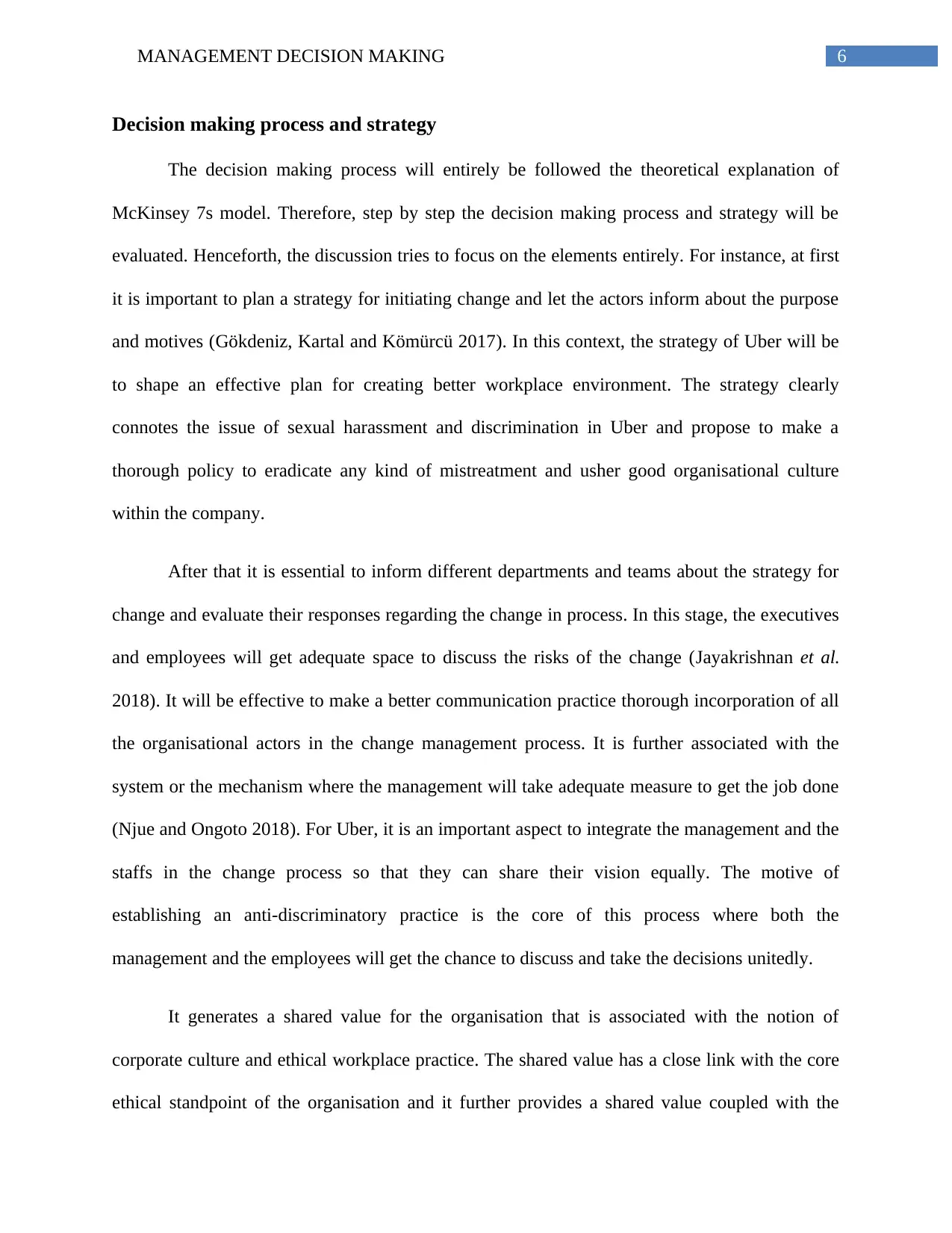
6MANAGEMENT DECISION MAKING
Decision making process and strategy
The decision making process will entirely be followed the theoretical explanation of
McKinsey 7s model. Therefore, step by step the decision making process and strategy will be
evaluated. Henceforth, the discussion tries to focus on the elements entirely. For instance, at first
it is important to plan a strategy for initiating change and let the actors inform about the purpose
and motives (Gökdeniz, Kartal and Kömürcü 2017). In this context, the strategy of Uber will be
to shape an effective plan for creating better workplace environment. The strategy clearly
connotes the issue of sexual harassment and discrimination in Uber and propose to make a
thorough policy to eradicate any kind of mistreatment and usher good organisational culture
within the company.
After that it is essential to inform different departments and teams about the strategy for
change and evaluate their responses regarding the change in process. In this stage, the executives
and employees will get adequate space to discuss the risks of the change (Jayakrishnan et al.
2018). It will be effective to make a better communication practice thorough incorporation of all
the organisational actors in the change management process. It is further associated with the
system or the mechanism where the management will take adequate measure to get the job done
(Njue and Ongoto 2018). For Uber, it is an important aspect to integrate the management and the
staffs in the change process so that they can share their vision equally. The motive of
establishing an anti-discriminatory practice is the core of this process where both the
management and the employees will get the chance to discuss and take the decisions unitedly.
It generates a shared value for the organisation that is associated with the notion of
corporate culture and ethical workplace practice. The shared value has a close link with the core
ethical standpoint of the organisation and it further provides a shared value coupled with the
Decision making process and strategy
The decision making process will entirely be followed the theoretical explanation of
McKinsey 7s model. Therefore, step by step the decision making process and strategy will be
evaluated. Henceforth, the discussion tries to focus on the elements entirely. For instance, at first
it is important to plan a strategy for initiating change and let the actors inform about the purpose
and motives (Gökdeniz, Kartal and Kömürcü 2017). In this context, the strategy of Uber will be
to shape an effective plan for creating better workplace environment. The strategy clearly
connotes the issue of sexual harassment and discrimination in Uber and propose to make a
thorough policy to eradicate any kind of mistreatment and usher good organisational culture
within the company.
After that it is essential to inform different departments and teams about the strategy for
change and evaluate their responses regarding the change in process. In this stage, the executives
and employees will get adequate space to discuss the risks of the change (Jayakrishnan et al.
2018). It will be effective to make a better communication practice thorough incorporation of all
the organisational actors in the change management process. It is further associated with the
system or the mechanism where the management will take adequate measure to get the job done
(Njue and Ongoto 2018). For Uber, it is an important aspect to integrate the management and the
staffs in the change process so that they can share their vision equally. The motive of
establishing an anti-discriminatory practice is the core of this process where both the
management and the employees will get the chance to discuss and take the decisions unitedly.
It generates a shared value for the organisation that is associated with the notion of
corporate culture and ethical workplace practice. The shared value has a close link with the core
ethical standpoint of the organisation and it further provides a shared value coupled with the
Paraphrase This Document
Need a fresh take? Get an instant paraphrase of this document with our AI Paraphraser
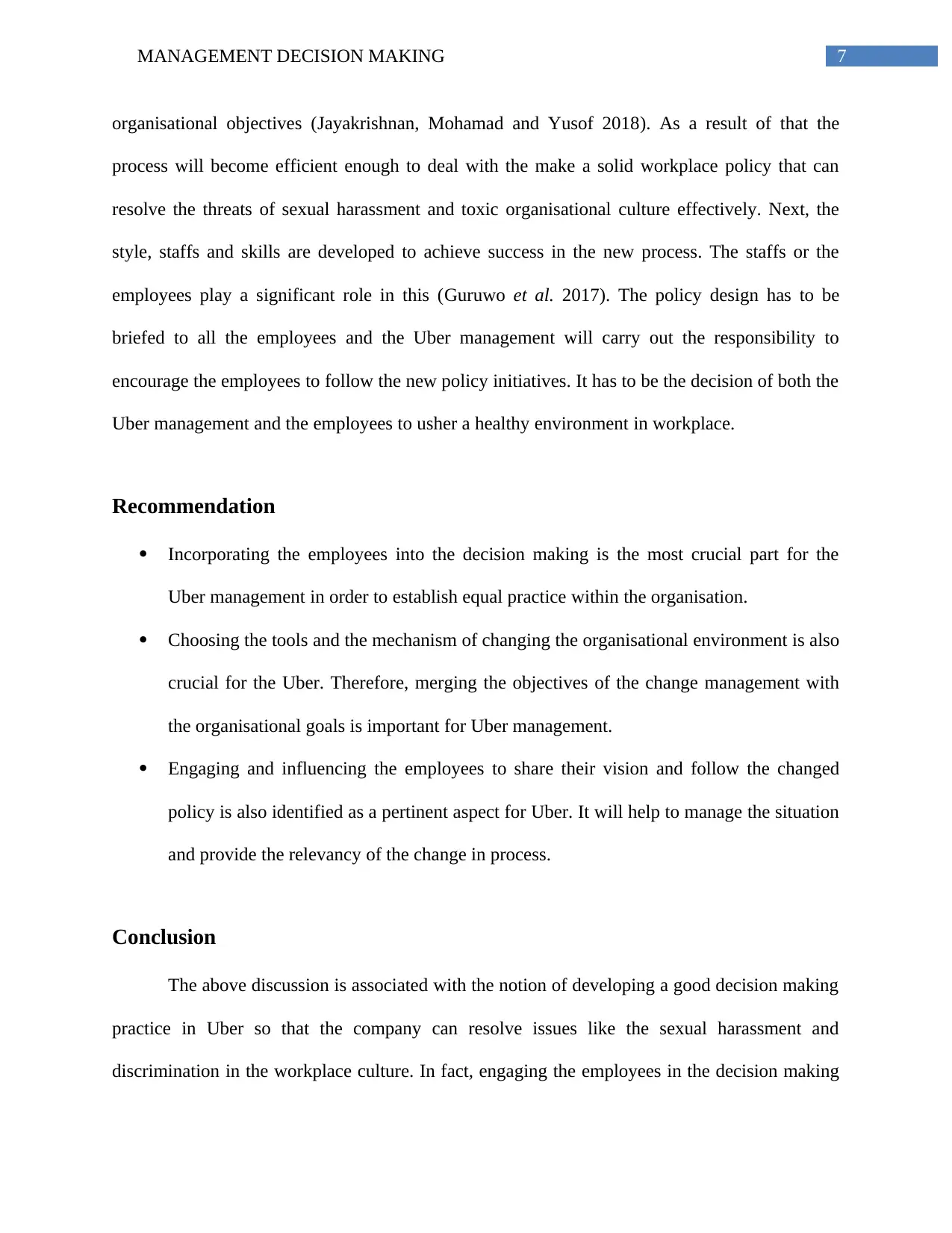
7MANAGEMENT DECISION MAKING
organisational objectives (Jayakrishnan, Mohamad and Yusof 2018). As a result of that the
process will become efficient enough to deal with the make a solid workplace policy that can
resolve the threats of sexual harassment and toxic organisational culture effectively. Next, the
style, staffs and skills are developed to achieve success in the new process. The staffs or the
employees play a significant role in this (Guruwo et al. 2017). The policy design has to be
briefed to all the employees and the Uber management will carry out the responsibility to
encourage the employees to follow the new policy initiatives. It has to be the decision of both the
Uber management and the employees to usher a healthy environment in workplace.
Recommendation
Incorporating the employees into the decision making is the most crucial part for the
Uber management in order to establish equal practice within the organisation.
Choosing the tools and the mechanism of changing the organisational environment is also
crucial for the Uber. Therefore, merging the objectives of the change management with
the organisational goals is important for Uber management.
Engaging and influencing the employees to share their vision and follow the changed
policy is also identified as a pertinent aspect for Uber. It will help to manage the situation
and provide the relevancy of the change in process.
Conclusion
The above discussion is associated with the notion of developing a good decision making
practice in Uber so that the company can resolve issues like the sexual harassment and
discrimination in the workplace culture. In fact, engaging the employees in the decision making
organisational objectives (Jayakrishnan, Mohamad and Yusof 2018). As a result of that the
process will become efficient enough to deal with the make a solid workplace policy that can
resolve the threats of sexual harassment and toxic organisational culture effectively. Next, the
style, staffs and skills are developed to achieve success in the new process. The staffs or the
employees play a significant role in this (Guruwo et al. 2017). The policy design has to be
briefed to all the employees and the Uber management will carry out the responsibility to
encourage the employees to follow the new policy initiatives. It has to be the decision of both the
Uber management and the employees to usher a healthy environment in workplace.
Recommendation
Incorporating the employees into the decision making is the most crucial part for the
Uber management in order to establish equal practice within the organisation.
Choosing the tools and the mechanism of changing the organisational environment is also
crucial for the Uber. Therefore, merging the objectives of the change management with
the organisational goals is important for Uber management.
Engaging and influencing the employees to share their vision and follow the changed
policy is also identified as a pertinent aspect for Uber. It will help to manage the situation
and provide the relevancy of the change in process.
Conclusion
The above discussion is associated with the notion of developing a good decision making
practice in Uber so that the company can resolve issues like the sexual harassment and
discrimination in the workplace culture. In fact, engaging the employees in the decision making
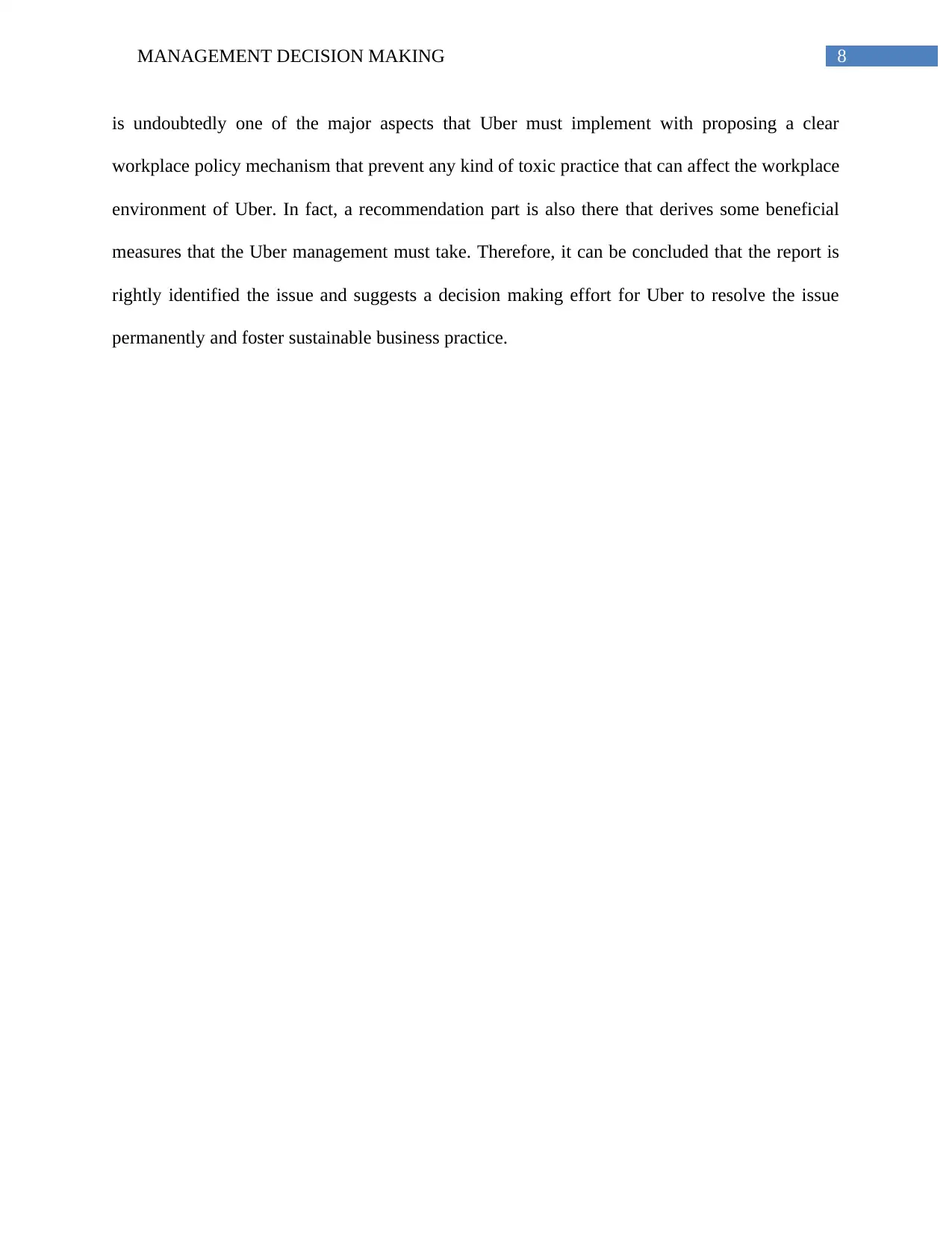
8MANAGEMENT DECISION MAKING
is undoubtedly one of the major aspects that Uber must implement with proposing a clear
workplace policy mechanism that prevent any kind of toxic practice that can affect the workplace
environment of Uber. In fact, a recommendation part is also there that derives some beneficial
measures that the Uber management must take. Therefore, it can be concluded that the report is
rightly identified the issue and suggests a decision making effort for Uber to resolve the issue
permanently and foster sustainable business practice.
is undoubtedly one of the major aspects that Uber must implement with proposing a clear
workplace policy mechanism that prevent any kind of toxic practice that can affect the workplace
environment of Uber. In fact, a recommendation part is also there that derives some beneficial
measures that the Uber management must take. Therefore, it can be concluded that the report is
rightly identified the issue and suggests a decision making effort for Uber to resolve the issue
permanently and foster sustainable business practice.
⊘ This is a preview!⊘
Do you want full access?
Subscribe today to unlock all pages.

Trusted by 1+ million students worldwide
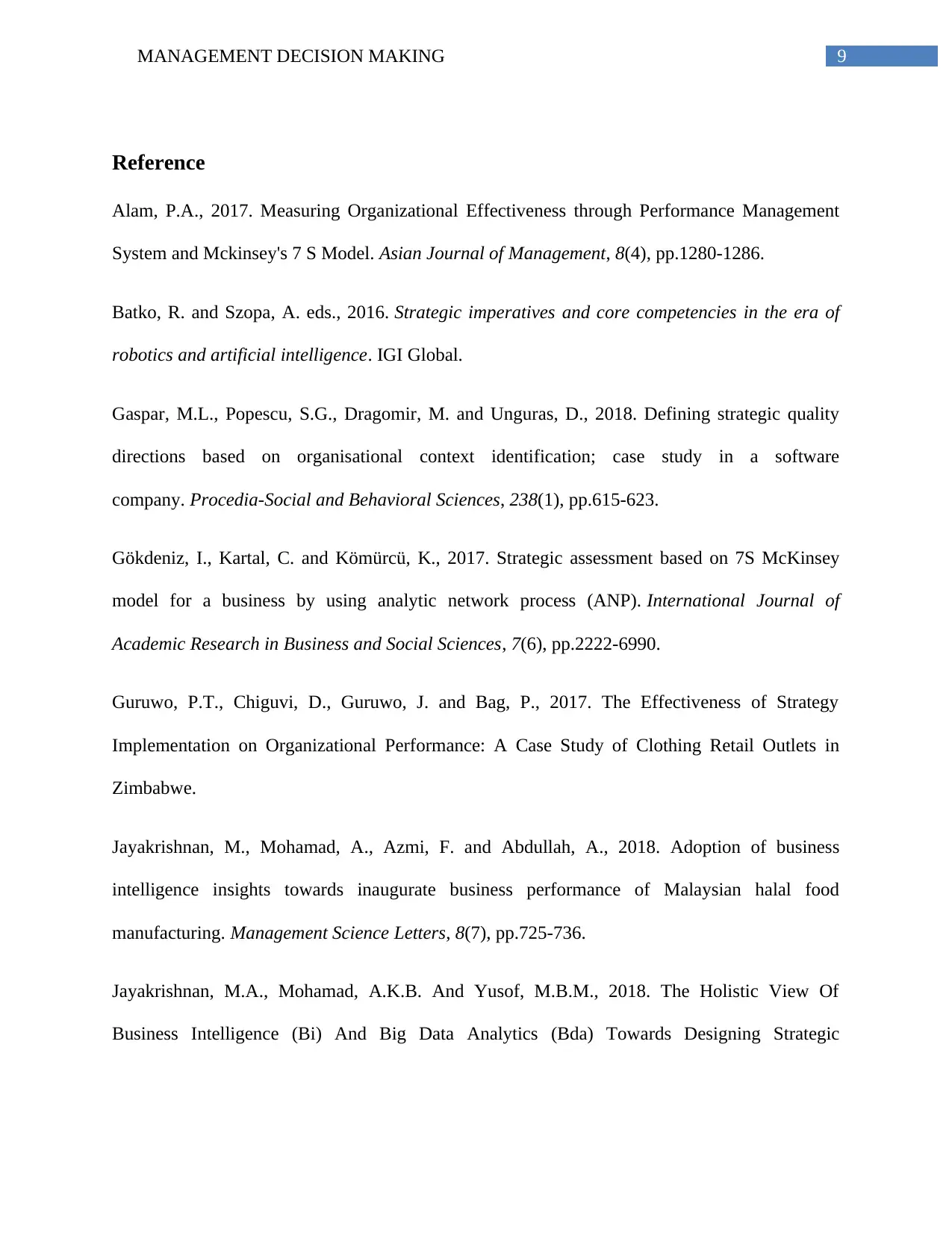
9MANAGEMENT DECISION MAKING
Reference
Alam, P.A., 2017. Measuring Organizational Effectiveness through Performance Management
System and Mckinsey's 7 S Model. Asian Journal of Management, 8(4), pp.1280-1286.
Batko, R. and Szopa, A. eds., 2016. Strategic imperatives and core competencies in the era of
robotics and artificial intelligence. IGI Global.
Gaspar, M.L., Popescu, S.G., Dragomir, M. and Unguras, D., 2018. Defining strategic quality
directions based on organisational context identification; case study in a software
company. Procedia-Social and Behavioral Sciences, 238(1), pp.615-623.
Gökdeniz, I., Kartal, C. and Kömürcü, K., 2017. Strategic assessment based on 7S McKinsey
model for a business by using analytic network process (ANP). International Journal of
Academic Research in Business and Social Sciences, 7(6), pp.2222-6990.
Guruwo, P.T., Chiguvi, D., Guruwo, J. and Bag, P., 2017. The Effectiveness of Strategy
Implementation on Organizational Performance: A Case Study of Clothing Retail Outlets in
Zimbabwe.
Jayakrishnan, M., Mohamad, A., Azmi, F. and Abdullah, A., 2018. Adoption of business
intelligence insights towards inaugurate business performance of Malaysian halal food
manufacturing. Management Science Letters, 8(7), pp.725-736.
Jayakrishnan, M.A., Mohamad, A.K.B. And Yusof, M.B.M., 2018. The Holistic View Of
Business Intelligence (Bi) And Big Data Analytics (Bda) Towards Designing Strategic
Reference
Alam, P.A., 2017. Measuring Organizational Effectiveness through Performance Management
System and Mckinsey's 7 S Model. Asian Journal of Management, 8(4), pp.1280-1286.
Batko, R. and Szopa, A. eds., 2016. Strategic imperatives and core competencies in the era of
robotics and artificial intelligence. IGI Global.
Gaspar, M.L., Popescu, S.G., Dragomir, M. and Unguras, D., 2018. Defining strategic quality
directions based on organisational context identification; case study in a software
company. Procedia-Social and Behavioral Sciences, 238(1), pp.615-623.
Gökdeniz, I., Kartal, C. and Kömürcü, K., 2017. Strategic assessment based on 7S McKinsey
model for a business by using analytic network process (ANP). International Journal of
Academic Research in Business and Social Sciences, 7(6), pp.2222-6990.
Guruwo, P.T., Chiguvi, D., Guruwo, J. and Bag, P., 2017. The Effectiveness of Strategy
Implementation on Organizational Performance: A Case Study of Clothing Retail Outlets in
Zimbabwe.
Jayakrishnan, M., Mohamad, A., Azmi, F. and Abdullah, A., 2018. Adoption of business
intelligence insights towards inaugurate business performance of Malaysian halal food
manufacturing. Management Science Letters, 8(7), pp.725-736.
Jayakrishnan, M.A., Mohamad, A.K.B. And Yusof, M.B.M., 2018. The Holistic View Of
Business Intelligence (Bi) And Big Data Analytics (Bda) Towards Designing Strategic
Paraphrase This Document
Need a fresh take? Get an instant paraphrase of this document with our AI Paraphraser
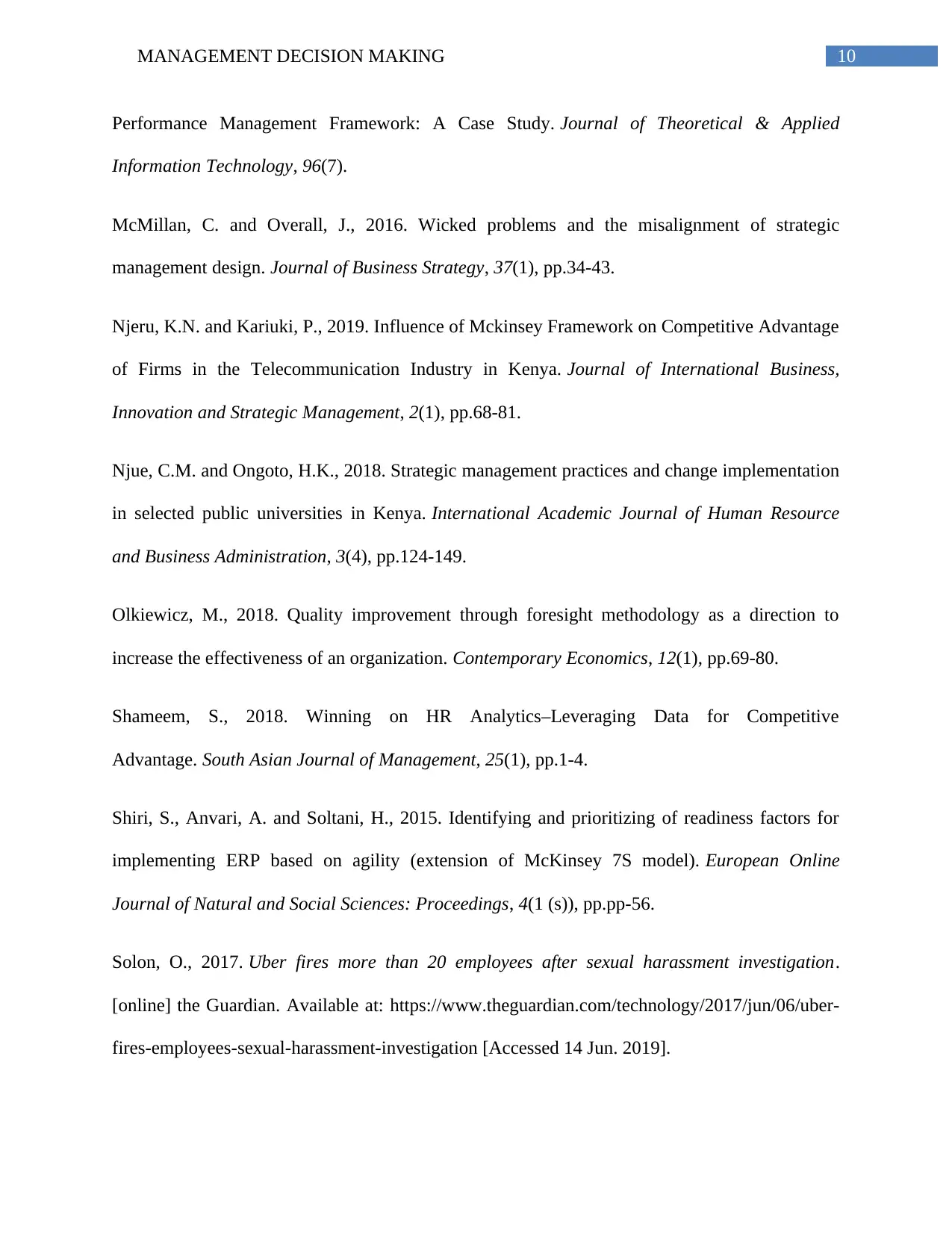
10MANAGEMENT DECISION MAKING
Performance Management Framework: A Case Study. Journal of Theoretical & Applied
Information Technology, 96(7).
McMillan, C. and Overall, J., 2016. Wicked problems and the misalignment of strategic
management design. Journal of Business Strategy, 37(1), pp.34-43.
Njeru, K.N. and Kariuki, P., 2019. Influence of Mckinsey Framework on Competitive Advantage
of Firms in the Telecommunication Industry in Kenya. Journal of International Business,
Innovation and Strategic Management, 2(1), pp.68-81.
Njue, C.M. and Ongoto, H.K., 2018. Strategic management practices and change implementation
in selected public universities in Kenya. International Academic Journal of Human Resource
and Business Administration, 3(4), pp.124-149.
Olkiewicz, M., 2018. Quality improvement through foresight methodology as a direction to
increase the effectiveness of an organization. Contemporary Economics, 12(1), pp.69-80.
Shameem, S., 2018. Winning on HR Analytics–Leveraging Data for Competitive
Advantage. South Asian Journal of Management, 25(1), pp.1-4.
Shiri, S., Anvari, A. and Soltani, H., 2015. Identifying and prioritizing of readiness factors for
implementing ERP based on agility (extension of McKinsey 7S model). European Online
Journal of Natural and Social Sciences: Proceedings, 4(1 (s)), pp.pp-56.
Solon, O., 2017. Uber fires more than 20 employees after sexual harassment investigation.
[online] the Guardian. Available at: https://www.theguardian.com/technology/2017/jun/06/uber-
fires-employees-sexual-harassment-investigation [Accessed 14 Jun. 2019].
Performance Management Framework: A Case Study. Journal of Theoretical & Applied
Information Technology, 96(7).
McMillan, C. and Overall, J., 2016. Wicked problems and the misalignment of strategic
management design. Journal of Business Strategy, 37(1), pp.34-43.
Njeru, K.N. and Kariuki, P., 2019. Influence of Mckinsey Framework on Competitive Advantage
of Firms in the Telecommunication Industry in Kenya. Journal of International Business,
Innovation and Strategic Management, 2(1), pp.68-81.
Njue, C.M. and Ongoto, H.K., 2018. Strategic management practices and change implementation
in selected public universities in Kenya. International Academic Journal of Human Resource
and Business Administration, 3(4), pp.124-149.
Olkiewicz, M., 2018. Quality improvement through foresight methodology as a direction to
increase the effectiveness of an organization. Contemporary Economics, 12(1), pp.69-80.
Shameem, S., 2018. Winning on HR Analytics–Leveraging Data for Competitive
Advantage. South Asian Journal of Management, 25(1), pp.1-4.
Shiri, S., Anvari, A. and Soltani, H., 2015. Identifying and prioritizing of readiness factors for
implementing ERP based on agility (extension of McKinsey 7S model). European Online
Journal of Natural and Social Sciences: Proceedings, 4(1 (s)), pp.pp-56.
Solon, O., 2017. Uber fires more than 20 employees after sexual harassment investigation.
[online] the Guardian. Available at: https://www.theguardian.com/technology/2017/jun/06/uber-
fires-employees-sexual-harassment-investigation [Accessed 14 Jun. 2019].
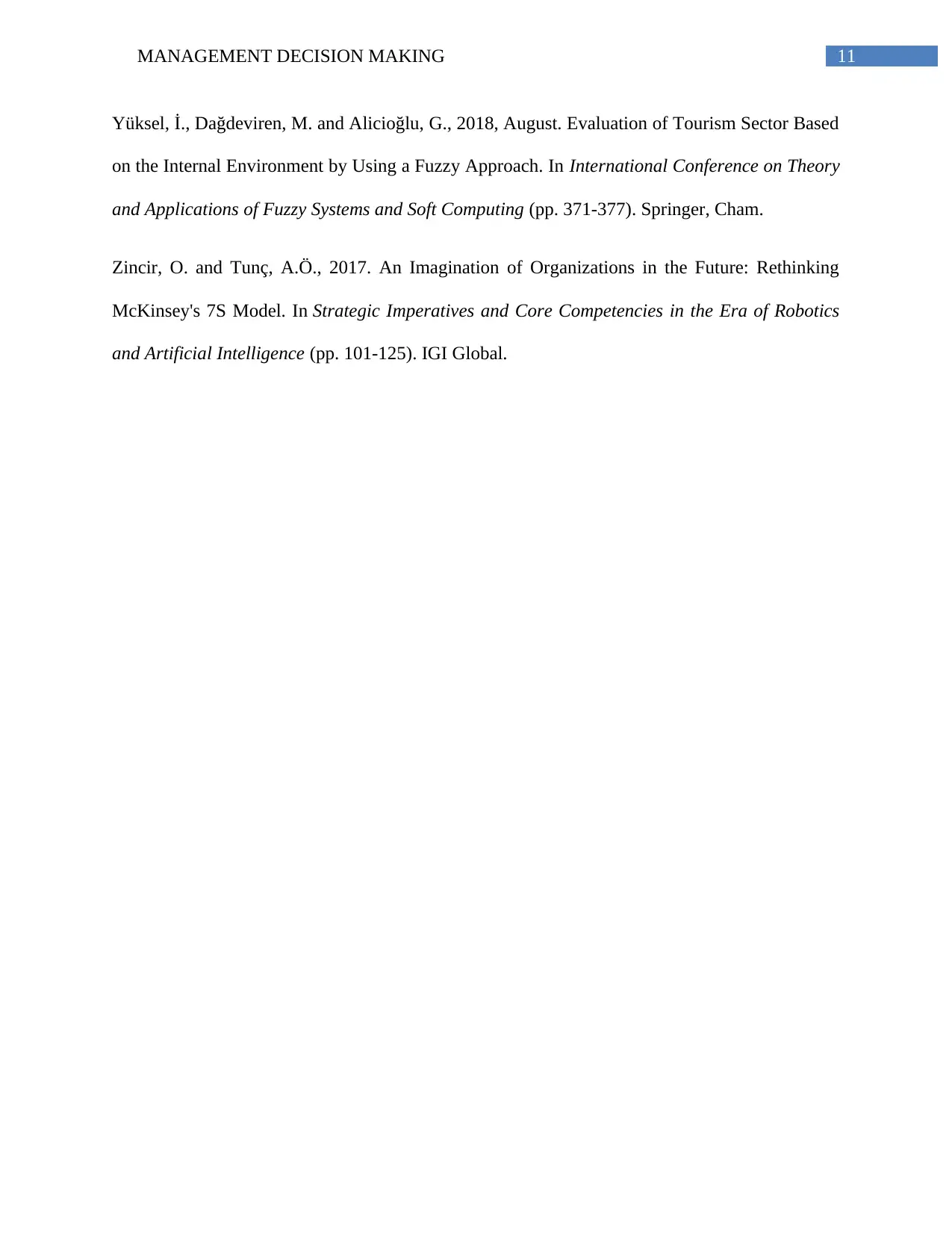
11MANAGEMENT DECISION MAKING
Yüksel, İ., Dağdeviren, M. and Alicioğlu, G., 2018, August. Evaluation of Tourism Sector Based
on the Internal Environment by Using a Fuzzy Approach. In International Conference on Theory
and Applications of Fuzzy Systems and Soft Computing (pp. 371-377). Springer, Cham.
Zincir, O. and Tunç, A.Ö., 2017. An Imagination of Organizations in the Future: Rethinking
McKinsey's 7S Model. In Strategic Imperatives and Core Competencies in the Era of Robotics
and Artificial Intelligence (pp. 101-125). IGI Global.
Yüksel, İ., Dağdeviren, M. and Alicioğlu, G., 2018, August. Evaluation of Tourism Sector Based
on the Internal Environment by Using a Fuzzy Approach. In International Conference on Theory
and Applications of Fuzzy Systems and Soft Computing (pp. 371-377). Springer, Cham.
Zincir, O. and Tunç, A.Ö., 2017. An Imagination of Organizations in the Future: Rethinking
McKinsey's 7S Model. In Strategic Imperatives and Core Competencies in the Era of Robotics
and Artificial Intelligence (pp. 101-125). IGI Global.
⊘ This is a preview!⊘
Do you want full access?
Subscribe today to unlock all pages.

Trusted by 1+ million students worldwide
1 out of 13
Related Documents
Your All-in-One AI-Powered Toolkit for Academic Success.
+13062052269
info@desklib.com
Available 24*7 on WhatsApp / Email
![[object Object]](/_next/static/media/star-bottom.7253800d.svg)
Unlock your academic potential
Copyright © 2020–2025 A2Z Services. All Rights Reserved. Developed and managed by ZUCOL.





